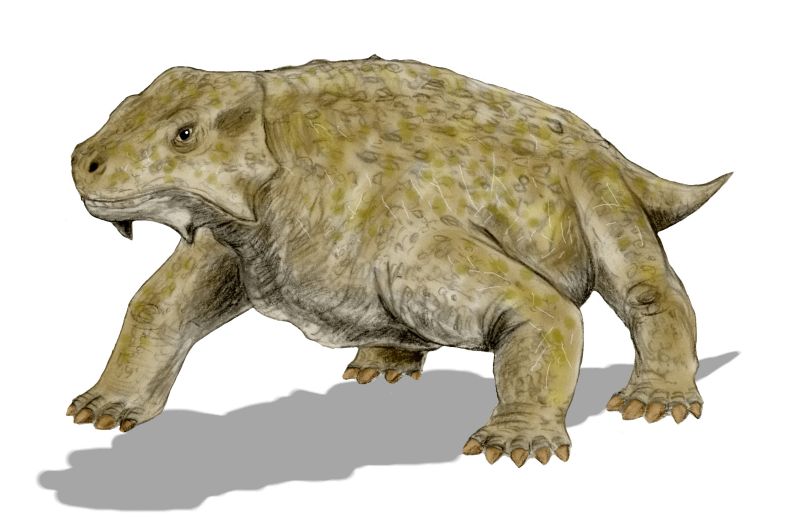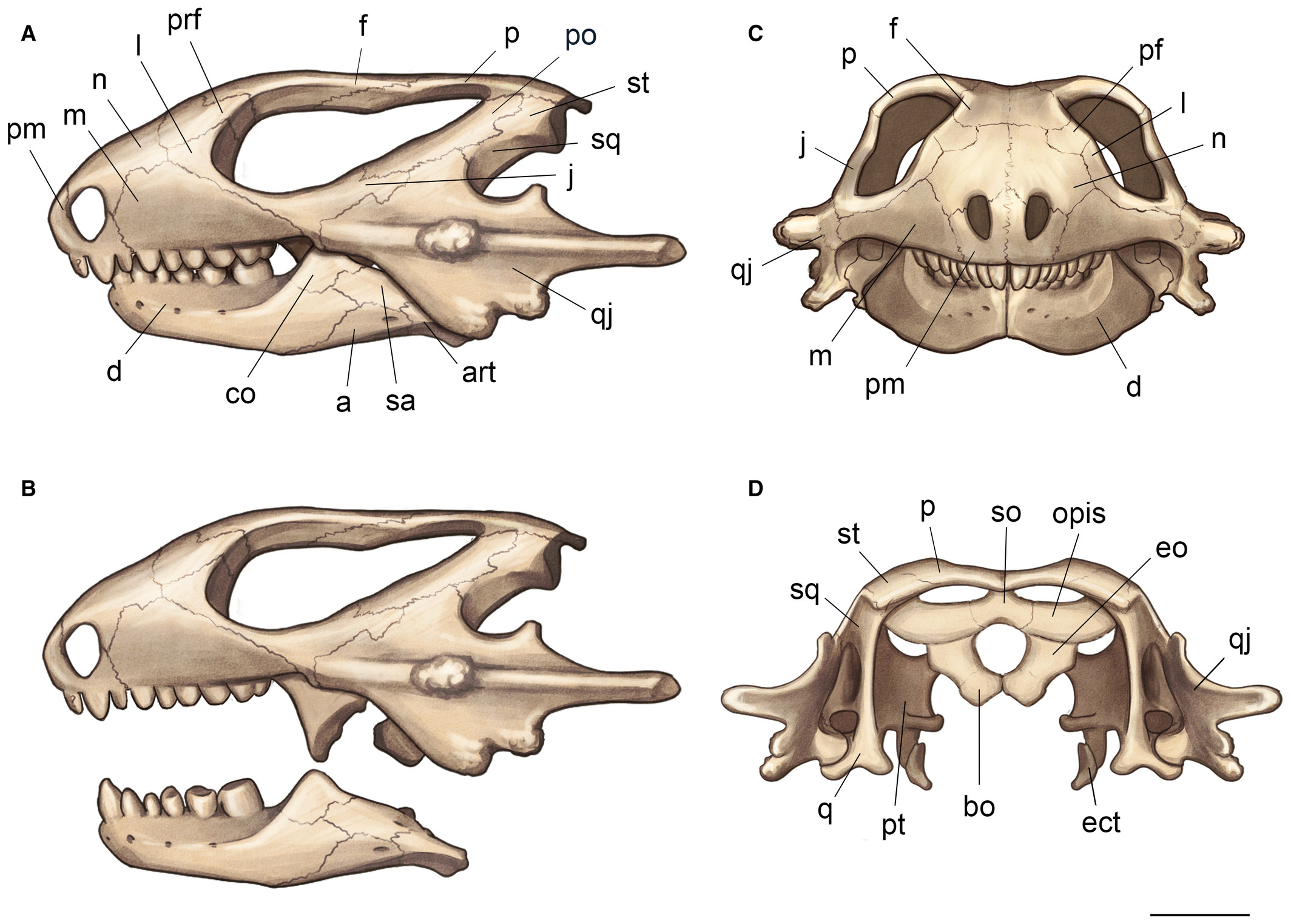|
Cotylosauria
image:Labidosaurus hamatus.JPG, Fossil of ''Labidosaurus, Labidosaurus hamatus'' Captorhinida (older name: Cotylosauria) is a doubly paraphyletic grouping of early reptiles. Robert L. Carroll (1988) ranked it as an order in the subclass Anapsida, composed of the following suborders:R. L. Carroll (1988), ''Vertebrate Paleontology and Evolution'', W. H. Freeman and Company, New York * A paraphyletic Captorhinomorpha, containing the families Protorothyrididae, Captorhinidae, Bolosauridae, Acleistorhinidae and possibly also Batropetidae * Procolophonia, containing families Nyctiphruretidae, Procolophonidae and Sclerosauridae * Pareiasauroidea, with families Rhipaeosauridae and Pareiasauridae * Millerosauroidea, with a single family Millerettidae. While they all share primitive features and resemble the ancestors of all modern reptiles, some of these families are more closely related to (or belong to) the clade Parareptilia, while others are further along the line leading to diapsids. F ... [...More Info...] [...Related Items...] OR: [Wikipedia] [Google] [Baidu] |
Procolophonia
Procolophonia is an extinct suborder (clade) of herbivorous reptiles that lived from the Middle Permian till the end of the Triassic period. They were originally included as a suborder of the Cotylosauria (later renamed Captorhinida Carroll 1988) but are now considered a clade of Parareptilia. They are closely related to other generally lizard-like Permian reptiles such as the Millerettidae, Bolosauridae, Acleistorhinidae, and Lanthanosuchidae, all of which are included under the Anapsida or "Parareptiles" (as opposed to the Eureptilia). Classification There are two main groups of Procolophonia, the small, lizard-like Procolophonoidea, and the Pareiasauroidea, which include the large, armoured Pareiasauridae. According to the traditional classification of Carroll 1988 as well as phylogenetic analyses of 2012, smaller groups like Rhipaeosauridae (now a synonym of Nycteroleteridae) and Sclerosauridae are classified with the pareiasaurs and with the procolophonids, ... [...More Info...] [...Related Items...] OR: [Wikipedia] [Google] [Baidu] |
Pareiasauridae
Pareiasaurs (meaning "cheek lizards") are an extinct clade of large, herbivorous parareptiles. Members of the group were armoured with osteoderms which covered large areas of the body. They first appeared in southern Pangea during the Middle Permian, before becoming globally distributed during the Late Permian. Pareiasaurs were the largest reptiles of the Permian, some reaching sizes over , equivalent to the largest contemporary therapsids. Pareiasaurs became extinct in the end-Permian mass extinction event. Description Pareiasaurs ranged in size from long, with some species estimated to exceed in body mass. The limbs of many parieasaurs were extremely robust, likely to account for the increased stress on their limbs caused by their typically sprawling posture. The cow-sized '' Bunostegos'' differed from other pareiasaurs by having a more upright limb posture, being amongst the first amniotes to develop this trait. Pareiasaurs were protected by bony scutes called osteoderms ... [...More Info...] [...Related Items...] OR: [Wikipedia] [Google] [Baidu] |
Captorhinidae
Captorhinidae is an extinct family of tetrapods, traditionally considered primitive Reptile, reptiles, known from the late Carboniferous to the Late Permian. They had a cosmopolitan distribution across Pangea. Description Captorhinids are a clade of small to very large lizard-like animals that date from the Late Carboniferous through the Permian. Their skulls were much stronger than those of their relatives, the protorothyridids, and had teeth that were better able to deal with tough plant material. The postcranial skeleton is similar to those of seymouriamorphs and diadectomorphs; these animals were grouped together with the captorhinids in the order Cotylosauria as the first reptiles in the early 20th century, but are now usually regarded as Stem group, stem-amniotes no closer to reptiles than to mammals. Captorhinids have broad, robust skulls that are generally triangular in shape when seen in dorsal view. The premaxillae are characteristically downturned. The largest captorh ... [...More Info...] [...Related Items...] OR: [Wikipedia] [Google] [Baidu] |
Pareiasauroidea
Pareiasaurs (meaning "cheek lizards") are an extinct clade of large, herbivorous parareptiles. Members of the group were armoured with osteoderms which covered large areas of the body. They first appeared in southern Pangea during the Middle Permian, before becoming globally distributed during the Late Permian. Pareiasaurs were the largest reptiles of the Permian, some reaching sizes over , equivalent to the largest contemporary therapsids. Pareiasaurs became extinct in the end-Permian mass extinction event. Description Pareiasaurs ranged in size from long, with some species estimated to exceed in body mass. The limbs of many parieasaurs were extremely robust, likely to account for the increased stress on their limbs caused by their typically sprawling posture. The cow-sized ''Bunostegos'' differed from other pareiasaurs by having a more upright limb posture, being amongst the first amniotes to develop this trait. Pareiasaurs were protected by bony scutes called osteoderms t ... [...More Info...] [...Related Items...] OR: [Wikipedia] [Google] [Baidu] |
Labidosaurus Hamatus
''Labidosaurus'' (from , 'forceps' and , 'lizard') is an extinct genus of captorhinid tetrapods from the Permian period of North America. Fossils have been discovered in Texas. It was heavily built, resembling a lizard with a large head, and measuring about long. Like most captorhinids, it was probably quadrupedal. Unlike many other captorhinids it had a single row of sharp, conical teeth in its jaws, and its dietary habits are assumed to have been omnivorous. A lower jaw of ''Labidosaurus'' was described in 2011 that shows evidence of osteomyelitis, or an infection of the bone. It is the earliest known example of an infection in a land vertebrate. The infection probably developed because the pulp cavity of a broken dentary tooth was exposed to bacteria Bacteria (; : bacterium) are ubiquitous, mostly free-living organisms often consisting of one Cell (biology), biological cell. They constitute a large domain (biology), domain of Prokaryote, prokaryotic microorgani ... [...More Info...] [...Related Items...] OR: [Wikipedia] [Google] [Baidu] |
Sclerosauridae
Procolophonidae is an extinct family of small, lizard-like parareptiles known from the Late Permian to Late Triassic that were distributed across Pangaea, having been reported from Europe, North America, China, South Africa, South America, Antarctica and Australia. The most primitive procolophonids were likely insectivorous or omnivorous, more derived members of the clade developed bicusped molars, and were likely herbivorous feeding on high fiber vegetation or durophagous omnivores. Many members of the group are noted for spines projecting from the quadratojugal bone of the skull, which likely served a defensive purpose as well as possibly also for display. At least some taxa were likely fossorial burrowers. While diverse during the Early and Middle Triassic, they had very low diversity during the Late Triassic, and were extinct by the beginning of the Jurassic. Phylogeny The family is defined as all taxa more closely related to ''Procolophon trigoniceps'' than to ''Owenetta ru ... [...More Info...] [...Related Items...] OR: [Wikipedia] [Google] [Baidu] |
Prehistoric Reptile Taxonomy
Prehistory, also called pre-literary history, is the period of human history between the first known use of stone tools by hominins million years ago and the beginning of recorded history with the invention of writing systems. The use of symbols, marks, and images appears very early among humans, but the earliest known writing systems appeared years ago. It took thousands of years for writing systems to be widely adopted, with writing having spread to almost all cultures by the 19th century. The end of prehistory therefore came at different times in different places, and the term is less often used in discussing societies where prehistory ended relatively recently. It is based on an old conception of history that without written records there could be no history. The most common conception today is that history is based on evidence, however the concept of prehistory hasn't been completely discarded. In the early Bronze Age, Sumer in Mesopotamia, the Indus Valley Civilis ... [...More Info...] [...Related Items...] OR: [Wikipedia] [Google] [Baidu] |
Diapsid
Diapsids ("two arches") are a clade of sauropsids, distinguished from more primitive eureptiles by the presence of two holes, known as temporal fenestrae, in each side of their skulls. The earliest traditionally identified diapsids, the araeoscelidians, appeared about three hundred million years ago during the late Carboniferous period. All diapsids other than the most primitive ones in the clade Araeoscelidia are often placed into the clade Neodiapsida. The diapsids are extremely diverse, and include birds and all modern reptile groups, including turtles, which were historically thought to lie outside the group. All modern reptiles and birds are placed within the neodiapsid subclade Sauria. Although some diapsids have lost either one hole (lizards), or both holes (snakes and turtles), or have a heavily restructured skull (modern birds), they are still classified as diapsids based on their ancestry. At least 17,084 species of diapsid animals are extant: 9,159 birds, and 7,925 s ... [...More Info...] [...Related Items...] OR: [Wikipedia] [Google] [Baidu] |
Parareptilia
Parareptilia ("near-reptiles") is an extinct group of basal sauropsids (" reptiles"), traditionally considered the sister taxon to Eureptilia (the group that likely contains all living reptiles and birds). Parareptiles first arose near the end of the Carboniferous period and achieved their highest diversity during the Permian period. Several ecological innovations were first accomplished by parareptiles among reptiles. These include the first reptiles to return to marine ecosystems (mesosaurs), the first bipedal reptiles ( bolosaurids such as '' Eudibamus''), the first reptiles with advanced hearing systems ( nycteroleterids and others), and the first large herbivorous reptiles (the pareiasaurs). The only parareptiles to survive into the Triassic period were the procolophonoids, a group of small generalists, omnivores, and herbivores. The largest family of procolophonoids, the procolophonids, rediversified in the Triassic, but subsequently declined and became extinct by t ... [...More Info...] [...Related Items...] OR: [Wikipedia] [Google] [Baidu] |
Millerettidae
Millerettidae is an extinct family of parareptiles from the Middle Permian to the Late Permian period ( Capitanian - Changhsingian stages) of South Africa. The millerettids were small insectivores and probably resembled modern lizards in appearance and lifestyle. The following cladogram shows the phylogenetic In biology, phylogenetics () is the study of the evolutionary history of life using observable characteristics of organisms (or genes), which is known as phylogenetic inference. It infers the relationship among organisms based on empirical dat ... position of the Millerettidae, from Ruta ''et al.'', 2011. References External linksBerkeley University information. Permian reptiles Prehistoric reptiles of Africa Guadalupian first appearances Lopingian extinctions Prehistoric reptile families {{Permian-reptile-stub ... [...More Info...] [...Related Items...] OR: [Wikipedia] [Google] [Baidu] |
Millerosauroidea
Millerosauria is an order of Parareptiles that contains the families †Millerettidae and † Eunotosauridae. It is the sister group to the order Procolophonomorpha. It was named in 1957 by Watson. It was once considered a suborder of the disused group Captorhinida and was called Millerosauroidea. All members of this order are thought to be extinct. ''Eunotosaurus ''Eunotosaurus'' (''Latin (language), Latin'': Stout-backed lizard) is an extinct genus of amniote, possibly a close relative of turtles. ''Eunotosaurus'' lived in the late Middle Permian (Capitanian stage) and fossils can be found in the Karoo ...'' has been recovered as a stem-turtle in recent cladistic studies.Schoch RR, Sues HD (2015) A Middle Triassic stem-turtle and the evolution of the turtle body plan. Nature doi: 10.1038/nature14472. pub ahead of print/ref> References * Parareptilia Prehistoric tetrapod orders Guadalupian first appearances Lopingian extinctions {{permian-reptile-stub ... [...More Info...] [...Related Items...] OR: [Wikipedia] [Google] [Baidu] |
Rhipaeosauridae
Nycteroleteridae is a family of procolophonian parareptilians (extinct early reptiles) from the Middle to Late Permian of Russia and North America. They are sometimes classified as a sister group to pareiasaurids (but see ''Classification)''. The group includes the genera '' Macroleter'', '' Bashkyroleter'', ''"Bashkyroleter" mesensis'', '' Nycteroleter'', '' Emeroleter'', and probably '' Rhipaeosaurus''. They were carnivorous, and occasionally ate insects. The group was most common in European Russia, with only a few fossils in North America. One fossil has also been found in Africa, but this is the only one from Gondwana. Classification Nycteroleteridae is sometimes considered a sister group to the Pareiasauridae, but Bayesian inference suggests that it was in fact paraphyletic, with '' Rhipaeosaurus'' a basal member of the Pareiasauridae and other members of the Nycteroleteridae as outgroups. This is supported by the appearance of ''Rhipaeosaurus skull and teeth - it had tri ... [...More Info...] [...Related Items...] OR: [Wikipedia] [Google] [Baidu] |





